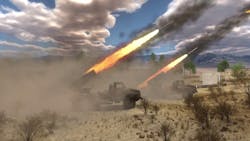Army asks industry for new electro-optical means to merge targeting for laser and conventional weapons
FORT BELVOIR, Va. – U.S. Army targeting experts are reaching out to industry for new ways of designing electro-optical beam director gimbals that merge high-energy laser targeting capability with conventional targeting capability.
Officials of the Army Rapid Capabilities and Critical Technologies Office (RCCTO) at Fort Belvoir, Va., released a request for information (W50RAJ-23-RFI-NBD) on Tuesday for the Novel Beam Directors project.
Merging conventional and high-energy laser targeting could enable combat aircraft, armored vehicles, surface warships, and artillery emplacements to combine effects from conventional kinetic weapons like bombs, missiles, and mortar shells with laser weapons as circumstances and targets dictate.
As high-energy laser weapons evolve, their deployment and use with conventional kinetic weapons is likely to increase, which will require military fire-control systems to handle all these kinds of weapons.
Army researchers want to expand their knowledge of these kinds of capabilities in the defense industry, non-traditional defense contractors, as well as colleges and universities. Army researchers will use this knowledge to develop acquisition strategies, statements of work, and statements of objectives.
Researchers are interested in ways to combine high-energy laser weapons and conventional weapons targeting in two assembly levels: beam director targeting gimbal systems with embedded processing and sensors; and targeting sensors and camera electronics only. Systems should not include cockpit displays and controls.
Industry responses may concern design concepts that describe optical layout, mechanical, electrical, and processing, as well as estimates with key milestones showing how long it would take to design a prototype equipment set; and rough estimates of costs.
Submissions should indicate key enabling technologies that require advance development, and describe any internal investments necessary for a successful effort. Submissions also should provide any additional recommendations the government should consider.
Companies interested should email 10-page capabilities statements no later than 3 March 2023 to the Army's Hillary Roy at [email protected] and Paul Kemp at [email protected].
More information is online at https://sam.gov/opp/dc550ebb85404766bb25cc903936d139/view.
About the Author
John Keller
Editor-in-Chief
John Keller is the Editor-in-Chief, Military & Aerospace Electronics Magazine--provides extensive coverage and analysis of enabling electronics and optoelectronic technologies in military, space and commercial aviation applications. John has been a member of the Military & Aerospace Electronics staff since 1989 and chief editor since 1995.
